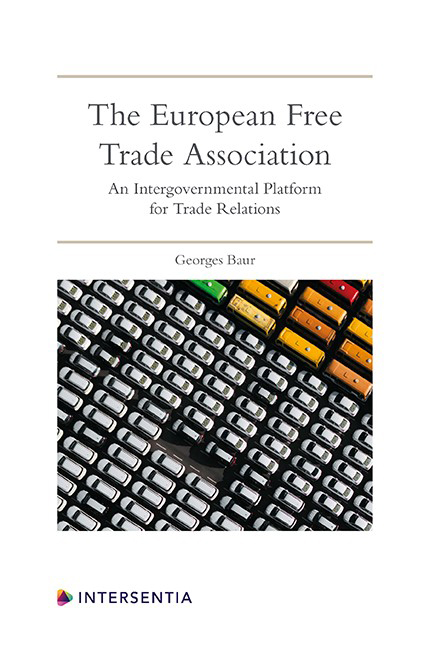Book contents
- Frontmatter
- Foreword
- Preface
- Acknowledgements
- Contents
- List of Tables and Figures
- Chapter 1 What is EFTA?
- Chapter 2 Short Historical Overview
- Chapter 3 Substantive Fields of Activity of EFTA
- Chapter 4 EFTA Institutions, Membership, Scope and Other General Provisions
- Chapter 5 Trade Relations with Third Countries and Groups of Countries
- Chapter 6 The Relations between the EFTA States and the EU/EEA
- Chapter 7 Conclusion: EFTA Membership for the UK Post-Brexit?
- Convention Establishing the European Free Trade Association
- Annex K. Free Movement of Persons (Chapter VIII)
- Annex T. Arbitration (Art. 48)
- Index
- About the Author
- Frontmatter
- Foreword
- Preface
- Acknowledgements
- Contents
- List of Tables and Figures
- Chapter 1 What is EFTA?
- Chapter 2 Short Historical Overview
- Chapter 3 Substantive Fields of Activity of EFTA
- Chapter 4 EFTA Institutions, Membership, Scope and Other General Provisions
- Chapter 5 Trade Relations with Third Countries and Groups of Countries
- Chapter 6 The Relations between the EFTA States and the EU/EEA
- Chapter 7 Conclusion: EFTA Membership for the UK Post-Brexit?
- Convention Establishing the European Free Trade Association
- Annex K. Free Movement of Persons (Chapter VIII)
- Annex T. Arbitration (Art. 48)
- Index
- About the Author
Summary
ONLY A CLASSICAL FREE TRADE AREA?
INTRODUCTION
European integration is very much about what kind of economic integration is intended between the states involved. Since the signing of the Treaty of Rome in 1957, the EU has moved through different stages: from the European Economic Community, to the European Communities and today's European Union. And although some goals were set from the beginning the next steps were seldom undisputed. If we now look further back, this dispute about what kind of economic integration should be favoured amongst the (then) Western European states, is the very reason why these split into those founding the EEC on the one hand and those who favoured a lighter structure and therefore set up EFTA, on the other. These different concepts are, however, not just of historical interest. They remain relevant in today's discussions, e.g. on what model of economic integration the UK should choose after Brexit or whether, in the case of Switzerland, a ‘comprehensive’ FTA could replace the current regime of sectoral access to the EU's internal market. In order to understand the differences between these approaches to European integration we will have to briefly examine the theory of economic integration. This will help us to better understand what is meant if these concepts are being used in national discussions.
STAGES OF ECONOMIC INTEGRATION
The theory of economic integration categorises the degree of economic integration into seven stages.
The basic form of economic cooperation is a preferential trade area or preferential trade agreement , if speaking of the instrument (PTA). It is a trading bloc or agreement that gives preferential access to certain of the participating countries ‘products. This is essentially done by reducing tariff s. These are, however, not abolished altogether. The line between a PTA and a free trade area (FTA) is not easy to draw and may be blurred. When concluding a PTA, the participating countries mostly aim at developing it into a FTA in accordance with the General Agreement on Tariff s and Trade (GATT). More generally, the term’ PTA ‘is also used to describe all types of economic integration since they all incorporate some degree of ‘preferred’ treatment. In particular, ‘PTA’ may also mean a Regional Trade Agreement (RTA).
- Type
- Chapter
- Information
- The European Free Trade AssociationAn Intergovernmental Platform for Trade Relations, pp. 1 - 8Publisher: IntersentiaPrint publication year: 2020



